Sony TC-WE425, TС-WE525, TС-WR681 Service Manual

TC-WE425/WE525/ WR681
SERVICE MANUAL
US Model
TC-WE425/WR681
|
Canadian Model |
|
TC-WE425 |
|
AEP Model |
|
TC-WE525/WR681 |
|
UK Model |
|
TC-WE525 |
|
E Model |
|
Australian Model |
Photo: TC-WE425 |
TC-WE425/WR681 |
|
|
|
Chinese Model |
|
TC-WE425 |
Dolby noise reduction extension manufactured under license from Dolby Laboratories Licensing Corporation.
HX Pro originated by Bang & Olufsen. “DOLBY”, the double-D symbol aand “HX PRO” are trademarks of Dolby Laboratories
Licensing Corporation.
Model Name Using Similar |
NEW |
|
Mechanism |
|
|
|
|
|
Tape Transport |
DECK A |
TCM-230ASR1 |
Mechanism Type |
DECK B |
TCM-230ASR2 |
|
|
|
SPECIFICATIONS
System
Recording system
4-track 2-channel stereo
Fast-winding time (approx.)
100 sec. (with Sony C-60 cassette)
Bias
AC bias
Signal-to-noise ratio (at peak level and weighted with Dolby NR off)
Type I tape, Sony Type I (NORMAL): 55 dB Type II tape, Sony Type II (HIGH): 57 dB Type IV tape, Sony Type IV (METAL): 58 dB
S/N ratio improvement (approximate values)
With Dolby B NR on: 5 dB at 1 kHz, 10 dB at 5 kHz With Dolby C NR on: 15 dB at 500 Hz, 20 dB at 1 kHz
Harmonic distortion
0.4% (with Type I tape, Sony Type I (NORMAL):
160 nWb/m 315 Hz, 3rd H.D.)
1.8% (with Type IV tape, Sony Type IV (METAL):
250 nWb/m 315 Hz, 3rd H.D.)
Frequency response (Dolby NR off)
Tape type
Type I tape, Sony Type I |
30-16,000 Hz (±3 dB, IEC), |
|
(NORMAL) |
20-17,000 Hz (±6 dB) |
|
|
|
|
Type II tape, Sony Type II |
30-17,000 |
Hz (±3 dB, IEC), |
(HIGH) |
20-18,000 |
Hz (±6 dB) |
|
|
|
Type IV tape, Sony Type IV |
30-19,000 |
Hz (±3 dB, IEC), |
(METAL) |
20-20,000 |
Hz (±6 dB), |
|
|
|
Wow and flutter
±0.15% W. Peak (IEC)
0.1% W. RMS (NAB)
±0.2% W. Peak (DIN)
– Continued on next page –
STEREO CASSETTE DECK
MICROFILM
– 1 –
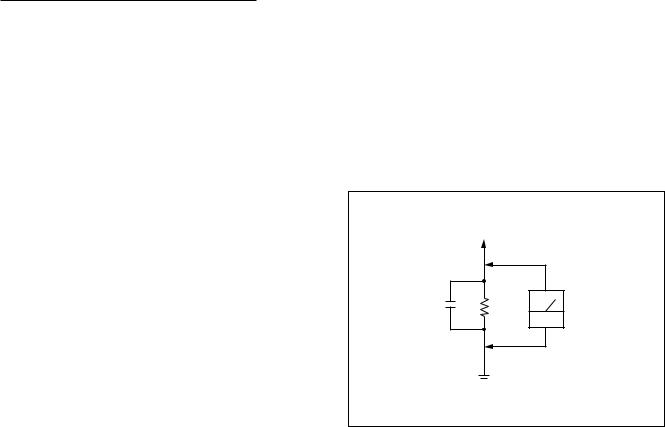
Inputs
Line inputs (phono jacks)
Sensitivity : 0.16 V
Input impedance : 47 kilohms
Outputs
Line outputs (phono jacks)
Rated output level : 0.5 V at a load impedance of 47 kilohms
Load impedance : Over 10 kilohms
Headphones (stereo phono jack) (TC-WE425/WE525 only)
Output level : 0.25 mW at a load impedance of 32 ohms
General
Power requirements
Where purchased |
Power requirements |
|
|
US, Canadian |
120 V AC, 60 Hz |
|
|
AEP, UK, Chinese |
220 - 230 V AC, 50/60 Hz |
|
|
Australian |
240 V AC, 50/60 Hz |
|
|
E, Singapore, Malaysia |
120/220/230 - 240 V AC, 50/60 Hz |
|
|
Power consumption |
|
18 W |
|
Dimensions (approx.) (w/h/d)
430 × 120 × 290 mm (w/h/d)
(17 × 4 3/4 × 11 3/8 in.)
including projecting parts and controls
Mass (approx.)
4 kg (8 lbs 13 oz)
Supplied accessories
Audio connecting cords (2 phono plugs - 2 phono plugs) (2)
CONTROL A1 cord (supplied for Canadian models only) (1)
Design and specifications are subject to change without notice.
SAFETY-RELATED COMPONENT WARNING!!
COMPONENTS IDENTIFIED BY MARK ! OR DOTTED LINE WITH MARK ! ON THE SCHEMATIC DIAGRAMS AND IN
THE PARTS LIST ARE CRITICAL TO SAFE OPERATION. REPLACE THESE COMPONENTS WITH SONY PARTS WHOSE PART NUMBERS APPEAR AS SHOWN IN THIS MANUAL OR IN SUPPLEMENTS PUBLISHED BY SONY.
SAFETY CHECK-OUT
After correcting the original service problem, perform the following safety check before releasing the set to the customer:
Check the antenna terminals, metal trim, “metallized” knobs, screws, and all other exposed metal parts for AC leakage. Check leakage as described below.
LEAKAGE TEST
The AC leakage from any exposed metal part to earth ground and from all exposed metal parts to any exposed metal part having a return to chassis, must not exceed 0.5 mA (500 microampers).
Leakage current can be measured by any one of three methods.
1.A commercial leakage tester, such as the Simpson 229 or RCA WT-540A. Follow the manufacturers’ instructions to use these instruments.
2.A battery-operated AC milliammeter. The Data Precision 245 digital multimeter is suitable for this job.
3.Measuring the voltage drop across a resistor by means of a VOM or battery-operated AC voltmeter. The “limit” indication is 0.75 V, so analog meters must have an accurate low-voltage scale. The Simpson 250 and Sanwa SH-63Trd are examples of a passive VOM that is suitable. Nearly all battery operated digital multimeters that have a 2V AC range are suitable. (See Fig. A)
To Exposed Metal
Parts on Set
0.15μF |
1.5kΩ |
AC |
voltmeter |
||
|
|
(0.75V) |
Earth Ground
Fig. A. Using an AC voltmeter to check AC leakage.
ATTENTION AU COMPOSANT AYANT RAPPORT À LA SÉCURITÉ!!
LES COMPOSANTS IDENTIFIÉS PAR UNE MARQUE !SUR LES
DIAGRAMMES SCHÉMATIQUES ET LA LISTE DES PIÈCES SONT CRITIQUES POUR LA SÉCURITÉ DE FONCTIONNEMENT. NE REMPLACER CES COMPOSANTS QUE PAR DES PIÈCES SONY DONT LES NUMÉROS SONT DONNÉS DANS CE MANUEL OU DANS LES SUPPLÉMENTS PUBLIÉS PAR SONY.
– 2 –

MODEL IDENTIFICATION
–Back panel–
|
Part No. |
|
|
Part No. |
Model |
|
|
3-021-244-0π |
TC-WE425 : US model |
3-021-244-1π |
TC-WE425 : CND model |
3-021-244-2π |
TC-WE525 : AEP model |
3-021-244-3π |
TC-WE525 : UK model |
3-021-244-4π |
TC-WE425 : AUS model |
3-021-244-5π |
TC-WE425 : SP, MY model |
3-021-244-6π |
TC-WE425 : CH model |
3-021-245-0π |
TC-WR681 : US model |
3-021-245-1π |
TC-WR681 : AEP model |
3-021-245-2π |
TC-WR681 : E model |
3-021-245-3π |
TC-WR681 : AUS model |
3-021-245-4π |
TC-WR681 : SP model |
|
|
•Abbreviation
CND : Canadian model AUS : Austrarian model
SP |
: Singapore model |
MY |
: Malaysia model |
CH |
: Chinese model |
TABLE OF CONTENTS
1. GENERAL
1-1. Location of Controls ........................................................... |
4 |
2. DISASSEMBLY
2-1. |
Case ..................................................................................... |
5 |
2-2. |
Front Panel Assy ................................................................. |
5 |
2-3. |
Cassette Lid Assy (Deck A/B) ............................................ |
6 |
2-4. |
Mechanism Deck Assy (Deck A/B) .................................... |
6 |
2-5. Leaf SW (A) board (Deck A), |
|
|
|
Leaf SW (B) board (Deck B) .............................................. |
7 |
2-6. Pinch Lever (FWD)/(REV) Assy (Deck A/B) ..................... |
8 |
|
2-7. |
Flywheel (FWD)/(REV) Assy (Deck A/B) ......................... |
8 |
2-8. |
Mechanical Block Assy (Deck A/B) ................................... |
9 |
2-9. |
Head Relay (PB) Board (Deck A), |
|
|
Head Relay (REC) Board (Deck B) .................................... |
9 |
3. MECHANICAL ADJUSTMENTS ............................... |
10 |
|
4. ELECTRICAL ADJUSTMENTS ................................. |
10 |
|
5. DIAGRAMS |
|
|
5-1. |
IC Pin Description ............................................................. |
14 |
5-2. |
Circuit Boards Location .................................................... |
16 |
5-3. |
Printed Wiring Boards –Main Section– ............................ |
17 |
5-4. |
Schematic Diagram –Main Section (1/3)– ........................ |
19 |
5-5. |
Schematic Diagram –Main Section (2/3)– ........................ |
21 |
5-6. |
Schematic Diagram –Main Section (3/3)– ........................ |
23 |
5-7. Printed Wiring Boards –Panel Section– ............................ |
25 |
|
5-8. |
Schematic Diagram –Panel Section– ................................ |
27 |
5-9. Printed Wiring Boards –Power Section– ........................... |
29 |
|
5-10. |
Schematic Diagram –Power Section– ............................... |
31 |
5-11. Printed Wiring Board –Deck A Section– ........................... |
32 |
|
5-12. Schematic Diagram –Deck A Section– ............................. |
32 |
|
5-13. |
Printed Wiring Board –Deck B Section– .......................... |
33 |
5-14. Schematic Diagram –Deck B Section– ............................. |
33 |
|
6. EXPLODED VIEWS |
|
|
6-1. |
Case Section ...................................................................... |
34 |
6-2. |
Chassis Section ................................................................. |
35 |
6-3. |
Cassette Holder Section .................................................... |
36 |
6-4. |
Front Panel Section ........................................................... |
37 |
6-5. |
Tape Mechanism Section .................................................. |
38 |
7. ELECTRICAL PARTS LIST ........................................ |
39 |
|
– 3 –

SECTION 1
GENERAL
1-1. LOCATION OF CONTROLS
5 |
6 |
7 |
8 |
9 |
|
1 |
|
|
|
|
21 |
|
|
|
|
20 |
|
|
|
|
|
|
|
2 |
|
|
|
|
19 |
|
|
|
|
|
|
3 |
|
|
|
|
|
4 |
|
|
|
|
18 |
|
|
|
|
|
17 |
|
|
|
|
|
16 |
10 |
11 |
12 |
13 |
14 |
15 |
1.1/u(Power) button (US, Canadian)
U(Power) button (EXCEPT US, Canadian)
2.DIRECTION MODE switch
3.PITCH CONTROL (ØON/øOFF) switch (TC-WE525)
4.PITCH CONTROL knob (TC-WE525)
5.Cassette holder (Deck A)
6.COUNTER A buttons (Deck A) RESET button
MEMORY button
7.Display window
8.COUNTER B buttons (Deck B) RESET button
MEMORY button
9.Cassette holder (Deck B)
10.Tape operation buttons (Deck A) 0 (REW) button
) (FF) button
p CLEAR (Stop) button ª (Reverse play) button · (Foward play) button
11.§(Eject) button (Deck A)
12.DOLBY NR switch
13.Tape operation buttons (Deck B) 0 (REW) button
) (FF) button p (Stop) button
ª (Reverse play) button · (Foward play) button P PAUSE button
R REC MUTING button r REC button
14.§(Eject) button (Deck B)
15.START (DECK B P) button HIGH/NORMAL, DUBBING AnB button
16.PHONES jack (TC-WE425/WE525)
17.SYNCHRO button and indicator (TC-WE425/WE525)
18.ARL button
19.FADER button
20.REC LEVEL knob
21.AUTO indicator
– 4 –
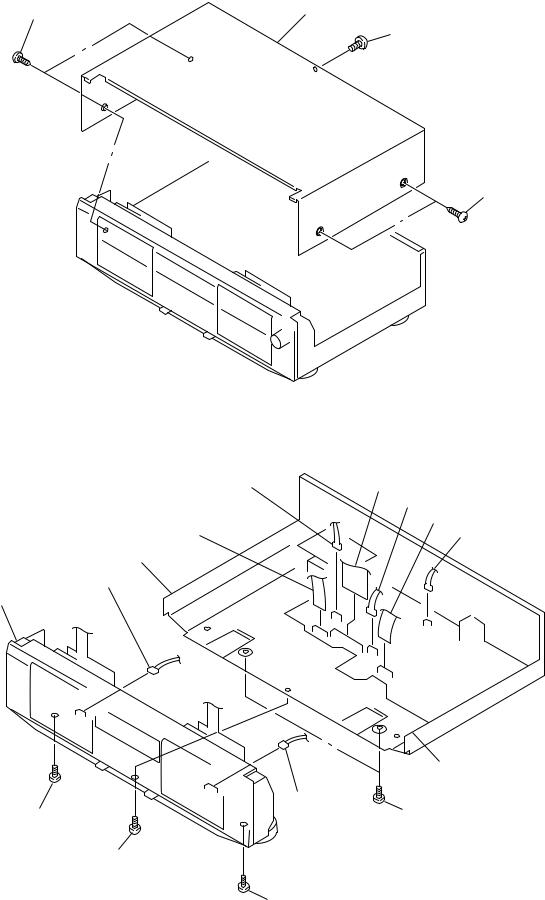
SECTION 2
DISASSEMBLY
Note : Follow the disassembly procedure in the numerical order given.
2-1. CASE
3 screws |
4 case |
|
|
(case 3 TP2) |
1 BVTP 3x8 |
|
2 screws (case 3 TP2)
2-2. FRONT PANEL ASSY
2 CN621 |
3 CN601 |
|
4 CN611 |
|
5 CN411 |
1 CN311 |
6 CN591 |
(WE425/WE525)
!£ claw
7 CN1002
! front panel assy
|
!¢ claw |
|
8 CN1003 |
0 BVTP 3x8 |
9 BVTT 3x6 |
!¡ BVTP 3x8
!™ BVTP 3x8
– 5 –
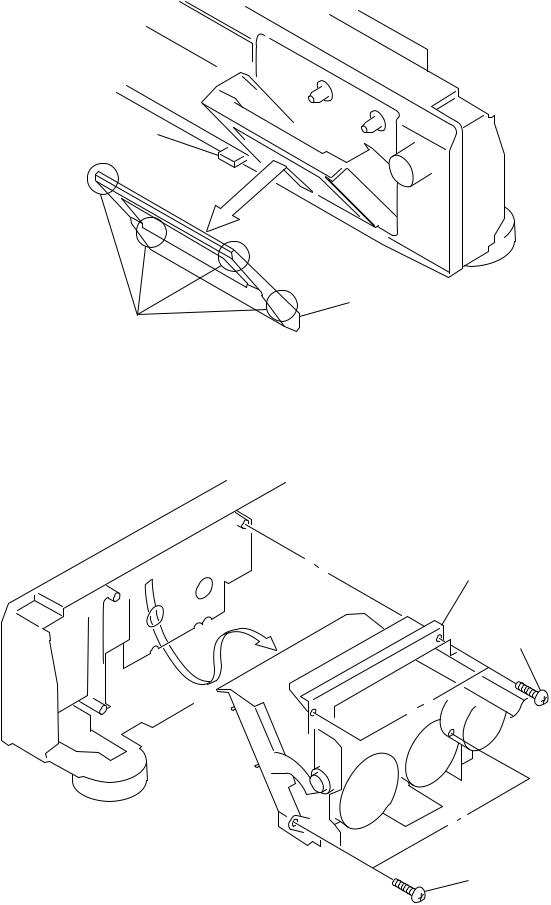
2-3. CASSETTE LID ASSY (DECK A/B)
1 Push the EJECT button.
3 cassette lid assy
2 claws
2-4. MECHANISM DECK ASSY (DECK A/B)
3 mechanism deck assy
1 BVTP 2.6x8
2 BVTP 2.6x8
– 6 –
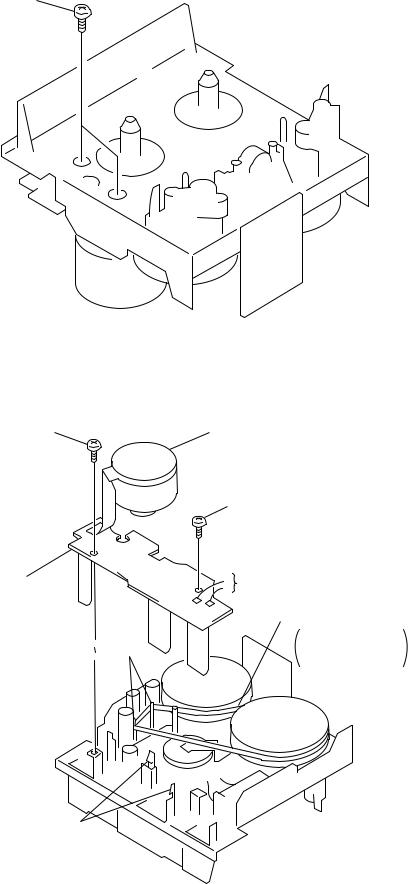
2-5. LEAF SW (A) BOARD (DECK A), LEAF SW (B) BOARD (DECK B)
1 PS 2.6x6
5 BVTT 2x4 |
2 capstan motor assy |
4 BVTT 2x4
7 LEAF SW (A) board |
a |
3 wires |
b |
||
(Deck A) |
|
|
LEAF SW (B) board |
|
8 belt (capstan) |
(Deck B) |
|
|
|
When installing, |
|
|
|
|
|
claws |
pull the belt (capstan) |
|
put around claws. |
|
|
|
b a
6 claws
– 7 –
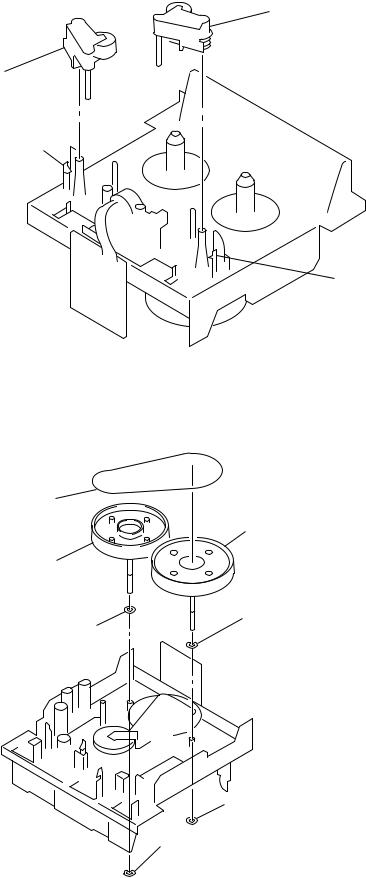
2-6. PINCH LEVER (FWD) / (REV) ASSY (DECK A/B)
4 pinch lever (FWD) assy
2 pinch lever (REV) assy
1 claw
3 claw
2-7. FLYWHEEL (FWD) / (REV) ASSY (DECK A/B)
1 belt (FR2)
3 flywheel (FWD) assy
6 flywheel (REV) assy
4 washer
7 washer
2 stopper washer
5 stopper washer
– 8 –
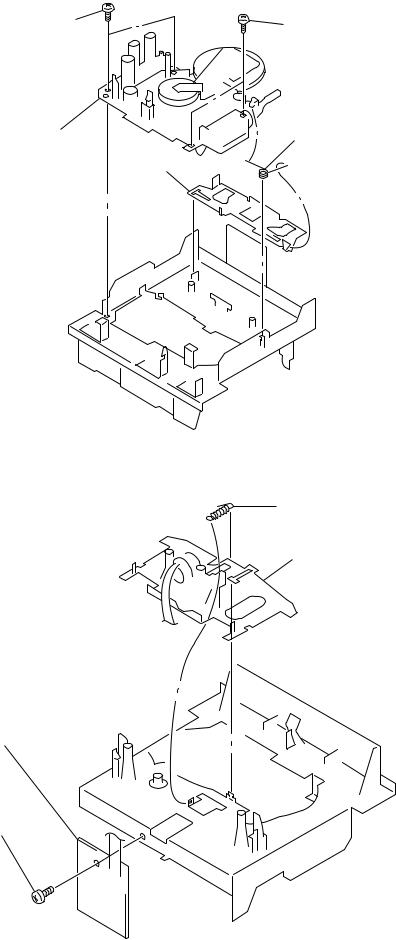
2-8. MECHANICAL BLOCK ASSY (DECK A/B)
3 BVTT 2x3 |
2 BVTT 2x3 |
4 mechanical block assy |
1 torsion spring |
5 reverse slider
2-9. HEAD RELAY (PB) BOARD (DECK A), HEAD RELAY (REC) BOARD (DECK B)
3 tension spring (HEAD)
4 head deck assy
2HEAD RELAY (PB) board
(Deck A)
HEAD RELAY (REC) board
(Deck B)
1 BVTT 2x4
– 9 –

SECTION 3
MECHANICAL ADJUSTMENTS
PRECAUTION
1.Clean the following parts with a denatured alcohol-moistened swab :
record/playback/erase head |
pinch roller |
rubber belts |
capstan |
idlers |
|
2.Demagnetize the record/playback head with a head demagnetizer.
3.Do not use a magnetized screwdriver for the adjustment.
4.After the adjustments, apply suitable locking compound to the parts adjusted.
5.The adjustments should be performed with the rated power supply voltage unless otherwise noted.
Torque Measurement
Mode |
Torque meter |
Meter reading |
|
|
|
|
|
Forward |
CQ-102C |
30 to 65 g • cm |
|
(0.42 to 0.90 oz • inch) |
|||
|
|
||
|
|
|
|
|
|
DECK A : 1 to 6 g • cm |
|
Forward |
|
(0.014 to 0.083 oz • inch) |
|
back |
CQ-102C |
|
|
tension |
|
DECK B : 2 to 9 g • cm |
|
|
|
(0.028 to 0.125 oz • inch) |
|
|
|
|
|
Reverse |
CQ-102RC |
30 to 65 g • cm |
|
(0.42 to 0.90 oz • inch) |
|||
|
|
||
|
|
|
|
Reverse |
|
1 to 6 g • cm |
|
back |
CQ-102RC |
||
(0.014 to 0.083 oz • inch) |
|||
tension |
|
||
|
|
||
|
|
|
|
FF/REW |
CQ-201B |
70 to 120 g • cm |
|
(0.97 to 1.67 oz • inch) |
|||
|
|
||
|
|
|
SECTION 4
ELECTRICAL ADJUSTMENTS
PRECAUTION
1.The adjustment should be performed in the publication. (Be sure to male playback adjustment at first.)
2.The adjustments and measurement should be performed for both L-CH and R-CH.
• Switch position
DOLBY NR switch : OFF DIRECTION MODE switch : A
• Standard record position :
Deliver the standard input signal level to input jack and set the REC LEVEL control to obtain the standard output signal level as follows.
– Record Mode–
AF OSC
level meter
attenuator |
10 k |
|
47 k |
|
|
set |
+ |
|
|
– |
|
|
|
|
|
600 |
|
|
|
LINE IN |
|
LINE OUT |
|
Standard Input Level
Input terminal |
|
LINE IN |
||
|
|
|
||
source impedance |
|
|
10 kΩ |
|
input signal level |
|
|
0.5 V (–3.8 dB) |
|
|
|
|
||
Standard Output Level |
|
|||
|
|
|
||
Output terminal |
|
LINE OUT |
||
load impedance |
|
|
47 kΩ |
|
output signal level |
|
|
0.5 V (–3.8 dB) |
|
|
|
|
|
|
Test Tape |
|
|
|
|
|
|
|
|
|
Tape |
Contents |
|
Use |
|
P-4-A100 |
10 kHz, –10 dB |
|
Azimuth Adjustment |
|
|
|
|
|
|
WS-48B |
3 kHz, 0 dB |
|
Tape Speed Adjustment |
|
|
|
|
|
|
P-4-L300 |
315 Hz, 0 dB |
|
PB Level Adjustment |
|
|
|
|
|
|
0 dB = 0.775 V
Test Mode
1.Turn ON power switch pressing “REC MUTING” and “ )” (FF) (DECK A) at the same time.
At first, all the fluorescent indicator light up, then the system returns to normal display. (However, “0. 00” is not displayed on the counter.)
2. To release the test mode, turn OFF the power switch.
– 10 –
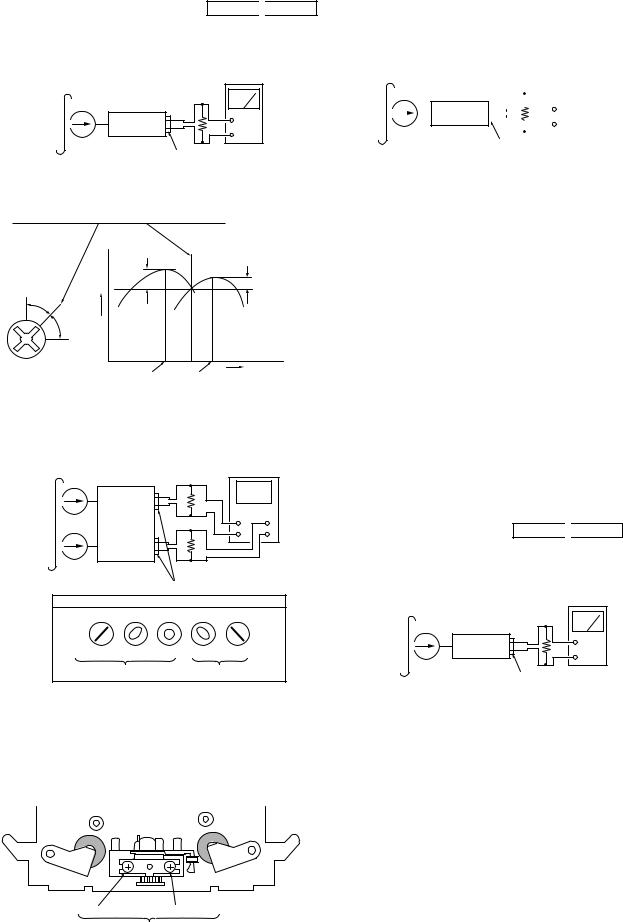
Record/Playback Head Azimuth Adjustment
DECK A 
 DECK B
DECK B
Procedure:
1. Forward Playback Mode
test tape |
|
|
P-4-A100 |
level meter |
|
(10 kHz, –10 dB) |
47 k |
|
|
||
set |
+ |
|
– |
||
|
||
|
LINE OUT |
2.Turn the adjustment screw for the maximum output levels. If these levels do not match, turn the adjustment screw until both of output levels match together within 1 dB.
L-CH |
output |
within |
|
within |
level |
1 dB |
|
||
peak |
|
|
1 dB |
|
|
|
|
||
R-CH |
|
|
|
|
peak |
|
|
screw position |
|
screw |
|
|
||
position |
|
L-CH |
R-CH |
|
|
|
peak |
peak |
|
3. Playback Mode |
|
|
|
|
test tape |
|
|
|
|
P-4-A100 |
|
|
oscilloscope |
|
(10 kHz, –10 dB) |
L-CH |
|||
|
|
47 k |
|
|
|
|
set |
V+ |
H+ |
|
|
|
– |
– |
|
|
R-CH |
47 k |
|
|
|
LINE OUT |
|
|
|
|
Screen Pattern |
|
|
|
In phase 45˚ 90˚ |
135˚ 180˚ |
|
|
|
|
good |
wrong |
|
4.Change the reverse playback mode and repeat the steps 1 to 3.
5.After the adjustment, lock the adjustment screws with suitable locking compound.
Adjustment Location: –record/playback head–
forward side |
reverse side |
adjustment screws
Tape Speed Adjustment |
DECK A |
|
|
DECK B |
|
|
||||||||||
Procedure: |
|
|
|
|
|
|||||||||||
–Forward Playback Mode– |
|
|
|
|
|
|||||||||||
test tape |
|
|
|
|
|
|||||||||||
WS-48B |
|
|
|
|
|
|||||||||||
(3 kHz, 0 dB) |
|
frequency counter |
||||||||||||||
|
|
|
|
|
|
|
|
47 k |
|
|||||||
|
|
|
|
|
|
|
|
|
|
|
|
|||||
|
|
|
|
|
|
|
|
|
|
|
|
|
|
|
|
|
|
|
|
|
|
|
|
|
|
|
|
|
|
|
+ |
|
|
|
|
|
|
set |
|
|
|
|
|
|
|
|
– |
|
||
|
|
|
|
|
|
|
|
|
|
|
|
|
||||
|
|
|
|
|
|
|
|
|
|
|
|
|
|
|
||
LINE OUT
(High speed adjustment)
1.Set to test mode. (Refer to page 10.)
2.Set to FWD playback mode.
3.Twice pressing the HIGH/NORMAL switch.
4.Adjust RV316 (DECK A), RV416 (DECK B) so that the frequency counter reading becomes 5,980 ± 20 Hz.
5.Release test mode after adjustment is completed. (Normal speed adjustment)
1.Set to FWD playback mode.
2.Adjust RV317 (DECK A), RV417 (DECK B) so that the frequency counter reading becomes 3,000 ± 10 Hz.
(Pitch control adjustment) (DECK A) (TC-WE525 only)
1.Push the PITCH CONTROL switch.
2.Set RV986 (PITCH CONTROL knob) to mechanical center.
3.Set to FWD playback mode.
4.Adjust RV318 so that the frequency counter reading becomes 2,990 ± 10 Hz.
Frequency difference between the beginning and the end of the tape should be within ± 3%.
Frequency difference between the deck A and deck B the beginning of the tape should be within ± 1.5%.
Adjustment Location: MAIN board (See page 13.)
Playback Level Adjustment DECK A 
 DECK B
DECK B
Procedure:
–Forward Playback Mode–
test tape |
|
|
P-4-L300 |
|
level meter |
(315 Hz, 0 dB) |
|
47 k |
|
|
|
|
set |
+ |
|
– |
|
|
|
|
|
|
LINE OUT |
Adjust DECK A : RV111 (L-CH), RV211 (R-CH) and
DECK B : RV121 (L-CH), RV221 (R-CH) so the level meter reading becomes the adjustment limits below.
Adjustment Value:
LINE OUT level : –7.7± 0.5 dB (0.301 to 0.338 V)
Level difference between channels : within 0.5 dB
Confirm that the LINE OUT level does not change in playback mode while changing the mode from playback to stop several times.
Adjustment Location: MAIN board (See page 13.)
– 11 –
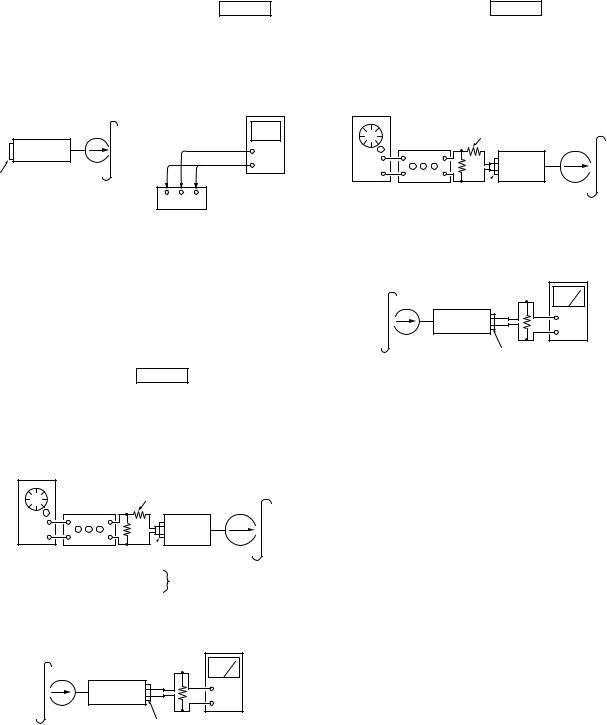
Bias Consumption Current Adjustment DECK B
This adjustment should be performed when replacing the head assy or the bias oscillator transformer (T131, T231).
Procedure:
digital blank tape voltmeter CS-413
set |
|
|
|
+ |
|
|
|
|
– |
LINE IN |
R-CH |
|
|
L-CH |
no signal |
1 |
2 |
3 |
TP431 |
|
1.Connect the digital voltmeter to test point TP431.
2.Set RV131 (L-CH), RV231 (R-CH) to mechanical center.
3.Set to FWD record mode.
4.Adjust T131 (L-CH), T231 (R-CH) so that the digital voltmeter reading becomes minimum.
Adjustment Value: Maximum 220 mV
Adjustment Location: MAIN board (See page 13.)
Record Bias Adjustment DECK B
Setting:
REC LEVEL control : standard record position (See page 10.)
Procedure:
1. Record Mode
AF OSC
10 k |
blank tape |
CS-123 |
attenuator
set
600  LINE IN
LINE IN
1) 315 Hz 38.8 mV (–26 dB)
2) 10 kHz
2. Playback Mode
recorded portion
|
level meter |
|
|
47 k |
|
set |
+ |
|
– |
||
|
||
|
LINE OUT |
Confirm that the 10 kHz playback output is 0 ± 0.5 dB relative to the 315 Hz output. If necessary, adjust RV131 (L-CH), RV231 (R- CH) and repeat the steps given above.
Adjustment Location: MAIN board (See page 13.)
Record Level Adjustment DECK B
Setting:
REC LEVEL control : standard record position (See page 10.)
Procedure:
1. Record Mode
AF OSC
blank tape
10 k |
CS-123 |
|
attenuator
set
600 
LINE IN
315 Hz, 38.8 mV (–26 dB)
2. Playback Mode
recorded |
|
level meter |
portion |
|
|
|
47 k |
|
|
|
|
|
set |
+ |
|
– |
|
|
|
|
|
|
LINE OUT |
Confirm playback the tape recorded become adjustment level as follows.
If necessary, adjust RV161 (L-CH), RV261 (R-CH) and repeat the steps 1 and 2.
Adjustment Value:
LINE OUT level : –26± 0.5 dB (36.7 to 41.1 mV)
Adjustment Location: MAIN board (See page 13.)
– 12 –
